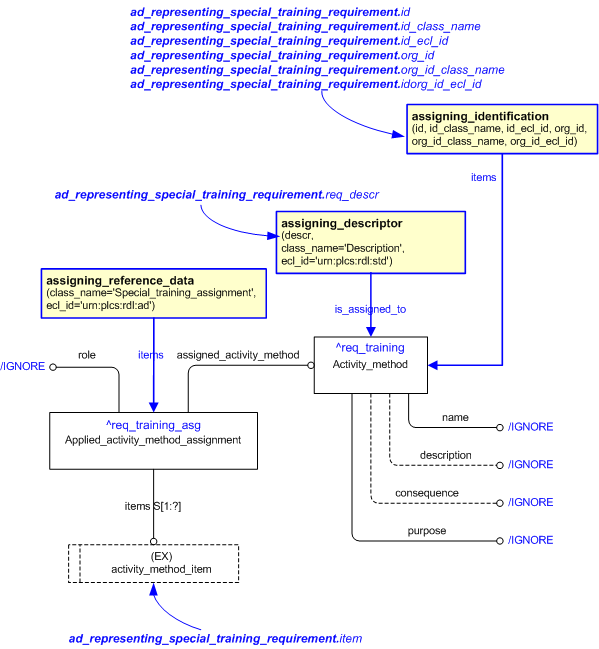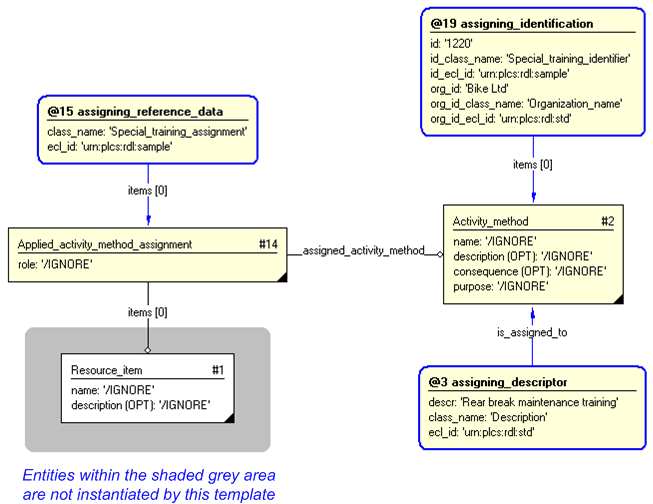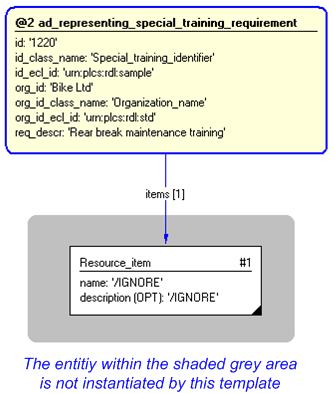Template:— ad_representing_special_training_requirement (ad_rep_spec_train_req)
Context:— Aerospace_and_Defense |
Date: 2011/04/20 13:25:53
Revision: 1.3
|
This section specifies the template ad_representing_special_training_requirement.
NOTE
The template has been defined in the context of
Aerospace_and_Defense.
Refer to the business context for details of related templates.
NOTE
An explanation of a template and the associated instantiation path is
provided in the
Template overview
section.
This template describes how to represent a description of special training required for a trade or a skill, in order to be
qualified to perform a specific task or subtask.
The EXPRESS-G diagram in
Figure
1
shows the templates and EXPRESS entities that are required
to represent the template
"ad_representing_special_training_requirement".
The text highlighted in blue shows the template parameters.
Figure 1 — An EXPRESS-G representation of the Information model for ad_representing_special_training_requirement
The graphic for the template to be used in other EXPRESS-G diagrams
is shown in Figure
2
below.
Figure 2 — The graphical representation of the ad_representing_special_training_requirement template
The following input parameters are defined for this template:
The identifier of the special training requirement.
id_class_name (Default=Activity_method_identification_code,Type='CLASS')
The name of the
External_class being used to classify the assigned special training requirement identifier (@id).
The following classes and their sub-classes can be used:
id_ecl_id (Default=urn:plcs:rdl:std,Type='URN')
The name or identifier of the organization that "owns" the special training requirement identifier (@id).
The name of the
External_class being used to classify the
identification or name of the organization (@org_id) that "owns" the special training requirement identifier (@id).
E.g. CAGE code or organization name.
The following classes and their sub-classes can be used:
Description of the special training required.
The item to which the
special training requirement is assigned.
The following reference parameters are defined for this template:
Allow the
Activity_method
entity instantiated in this path to be referenced when this template is used.
%^target = $ad_representing_special_training_requirement.req_training%
%^target = $ad_representing_special_training_requirement.req_training_asg%
The following parameter combinations specify a uniqueness constraint:
Unique constraint: Unique special training requirement
The instantiation path shown below specifies the entities that are to be
instantiated by the template.
A description of templates and the syntax for the instantiation path is
provided in the
Templates Help/Information section.
-- instantiate Activity_method Activity_method%^req_training =
Activity_method%
Activity_method.name = '/IGNORE'
Activity_method.description = '/IGNORE'
Activity_method.consequence = '/IGNORE'
Activity_method.purpose = '/IGNORE'
-- instantiate Applied_activity_method_assignment Applied_activity_method_assignment%^req_training_asg =
Applied_activity_method_assignment%
Applied_activity_method_assignment.role = '/IGNORE'
Applied_activity_method_assignment.items ->
@item-- Provide an identification of the special training requirement /
assigning_identification(
id=@id,
id_class_name=@id_class_name,
id_ecl_id=@id_ecl_id,
org_id=@org_id,
org_id_class_name=@org_id_class_name,
org_id_ecl_id=@org_id_ecl_id,
items= ^req_training)/
-- Provide the description of the special training requirement /
assigning_descriptor(
is_assigned_to=^req_training,
descr=@req_descr,
class_name='Description',
ecl_id='urn:plcs:rdl:std')/
-- Provide the role of the Applied_activity_method_assignment by the assignment of reference data /
assigning_reference_data(
items=^req_training_asg,
class_name='Special_training_assignment',
ecl_id='urn:plcs:rdl:ad')/
The following entities are instantiated with attributes as specified:
The instance diagram in Figure
3
shows an example of the EXPRESS entities and templates that are instantiated by the template:
/ad_representing_special_training_requirement(id='1220', id_class_name='Special_training_identifier', id_ecl_id='urn:plcs:rdl:sample', org_id='Bike Ltd', org_id_class_name='Organization_name', org_id_ecl_id='urn:plcs:rdl:std', req_descr='Rear break maintenance training', item='#1')/
(an illustration of the consolidated ad_representing_special_training_requirement template is shown in
Figure
4 below.)
Figure 3 — Entities instantiated by ad_representing_special_training_requirement template
The instance model in STEP ASCII exchange file format (ISO 10303 Part
21 syntax) is:
#1 = RESOURCE_ITEM('/IGNORE','/IGNORE',$);
#3 = ACTIVITY_METHOD('/IGNORE','/IGNORE','/IGNORE','/IGNORE');
#4 = APPLIED_ACTIVITY_METHOD_ASSIGNMENT($,(#1),'/IGNORE');
#6 = IDENTIFICATION_ASSIGNMENT('1220','/IGNORE','/IGNORE',(#3));
#8 = CLASSIFICATION_ASSIGNMENT(#9,(#6),'/IGNORE');
#9 = EXTERNAL_CLASS('/NULL','Special_training_identifier','/IGNORE',#10);
#10 = EXTERNAL_CLASS_LIBRARY('urn:plcs:rdl:sample','/IGNORE');
#13 = ORGANIZATION('/IGNORE','/IGNORE');
#15 = IDENTIFICATION_ASSIGNMENT('Bike Ltd','/IGNORE','/IGNORE',(#13));
#17 = CLASSIFICATION_ASSIGNMENT(#18,(#15),'/IGNORE');
#18 = EXTERNAL_CLASS('/NULL','Organization_name','/IGNORE',#19);
#19 = EXTERNAL_CLASS_LIBRARY('urn:plcs:rdl:std','/IGNORE');
#20 = ORGANIZATION_OR_PERSON_IN_ORGANIZATION_ASSIGNMENT(#13,'/IGNORE',(#6));
#22 = CLASSIFICATION_ASSIGNMENT(#23,(#20),'/IGNORE');
#23 = EXTERNAL_CLASS('/NULL','Owner_of','/IGNORE',#19);
#26 = DOCUMENT_ASSIGNMENT(#31,#3,'/IGNORE');
#28 = CLASSIFICATION_ASSIGNMENT(#29,(#26),'/IGNORE');
#29 = EXTERNAL_CLASS('/NULL','Description','/IGNORE',#19);
#31 = DOCUMENT('/IGNORE','/IGNORE','Rear break maintenance training');
#33 = CLASSIFICATION_ASSIGNMENT(#34,(#31),'/IGNORE');
#34 = EXTERNAL_CLASS('/NULL','Descriptor','/IGNORE',#19);
#37 = CLASSIFICATION_ASSIGNMENT(#38,(#4),'/IGNORE');
#38 = EXTERNAL_CLASS('/NULL','Special_training_assignment','/IGNORE',#39);
#39 = EXTERNAL_CLASS_LIBRARY('urn:plcs:rdl:ad','/IGNORE');
The instance diagram in
Figure
4
shows the graphic symbol for the template that is to be
used in other instance diagrams. The example template is:
/ad_representing_special_training_requirement(id='1220', id_class_name='Special_training_identifier', id_ecl_id='urn:plcs:rdl:sample', org_id='Bike Ltd', org_id_class_name='Organization_name', org_id_ecl_id='urn:plcs:rdl:std', req_descr='Rear break maintenance training', item='#1')/
Figure 4 — Instantiation of ad_representing_special_training_requirement template
Characterizations
No common characterizations of the template
ad_representing_special_training_requirement
have been identified. However, the ISO 10303-239 EXPRESS model
may enable other assignments to the entities instantiated by the template.




